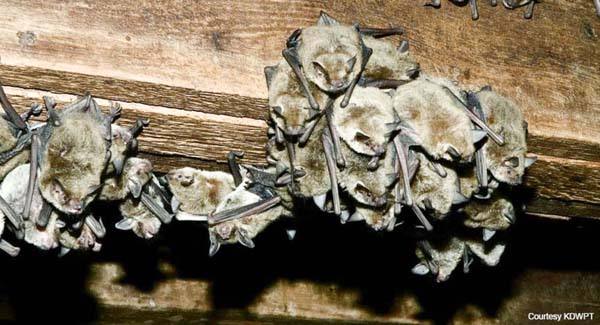The Kansas Departments of Health and Environment (KDHE) and Wildlife, Parks and Tourism (KDWPT) have had an increase in the number of calls recently from residents who have questions about bats in their homes. Experts from the State agencies encourage Kansans to be aware of the rabies risk associated with exposure to bats.
“Although only 3 percent of about 1,000 bats tested over the last five years were positive for rabies in Kansas, they remain an important cause of human rabies cases in the United States,” said Dr. Ingrid Garrison, State Public Health Veterinarian at KDHE. “Contact with bats is a concern because their teeth are so tiny that a bite may not be felt or even leave a noticeable mark. That is why it is important to speak with someone who can evaluate your situation for potential exposure to rabies,” said Dr. Garrison.
Rabies is a fatal viral disease in mammals, including people. Infection with the rabies virus can occur from a bite by a rabid animal or when saliva from a rabid animal comes into contact with the eyes, inside the mouth, or a fresh, open wound. In Kansas, skunks are the animal that most commonly tests positive for rabies.
“We see an increase in bat activity, usually in July and August, as baby bats learn to fly,” said Samantha Pounds, an ecologist with KDWPT. “Of the more than 1,000 species of bats around the world, 15 have been found in Kansas. Bats play a vital role in the Kansas ecosystem by consuming millions of insects each year, including agricultural pests and mosquitoes. They can eat one-half of their body weight in insects each night. However, some bats may also be infected with rabies. We want people to be aware of bats, but not afraid of them,” said Pounds.
It is best to exclude bats from your home in the early spring or fall, when they are not roosting (giving birth and raising young). Young bats that are not able to fly can get trapped inside, which can lead to an upset mother bat or foul-smelling dead bat. Bats often enter homes through unsealed cracks, gaps or small holes, so filling in these entry points is one way to keep bats out of a home. Another method is to use an exclusion tube or small piece of mesh to create a one-way exit for bats living in an attic. Professional help to exclude or capture bats may be available in your area.
KDHE asks that you call your health care provider or local health department if you have had any contact with a bat, if a bat is found in the room of a sleeping person, unattended child, or anyone who is unable to tell you about the encounter. If possible, the bat should be captured safely and not released. Tips for safely capturing a bat can be found on the Bat Conservation International website at www.batcon.org. If the bat is not available for rabies testing, the person who was exposed to the bat should seek medical care and receive rabies prevention shots.
KDHE and KDWPT offer the following tips about bats and other animals regarding rabies for your safety:
- If you wake up in a room with a bat present, regardless if there is evidence of a bite or scratch, seek advice from your health care provider or local health department. If possible, trap the bat for testing. Do not release the bat.
- If bitten by any animal, seek medical attention and report the bite to your local health department or animal control department immediately.
- If your animal is bitten, contact your veterinarian for advice.
- Do not handle or feed wild animals. Never adopt wild animals or bring them into your home; it is both unsafe and illegal.
- Do not try to nurse sick or injured wild animals back to health. Call animal control or an animal rescue agency for assistance.
- Teach children to never handle unfamiliar animals, wild or domestic, even if they appear friendly.
- Have your veterinarian vaccinate all dogs, cats, ferrets, horses and valuable livestock (cattle and sheep) against rabies.
For more information on bats and rabies visit: https://www.cdc.gov/rabies/bats/education/index.html. For more information on excluding or removing of bats: http://www.batcon.org/resources/for-specificissues/bats-in-buildings/faq.
A list of companies that are registered with the Kansas Nuisance Wildlife Damage Control Program (NADC Permit Holders) can be found on the KDWP&T website at https://ksoutdoors.com/Services/Wildlife-Damage-Control or by calling 620-672-5911. These companies may charge a fee for their services. For more information on rabies in Kansas: https://keap.kdhe.state.ks.us/Ephtm/PortalPages/ContentData?CID=109.
Kansas News Briefs
 Metro Voice News Celebrating Faith, Family & Community
Metro Voice News Celebrating Faith, Family & Community 








